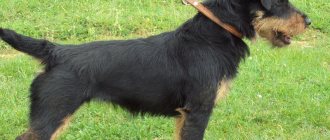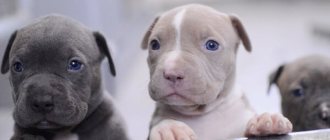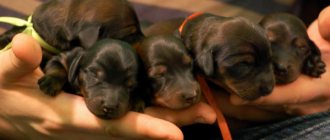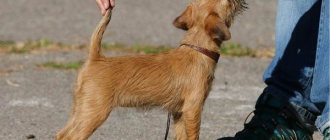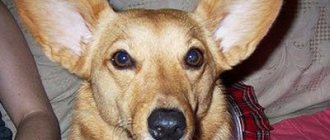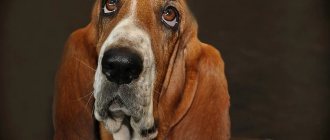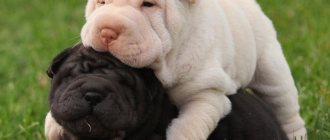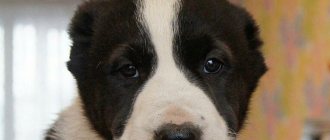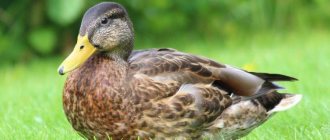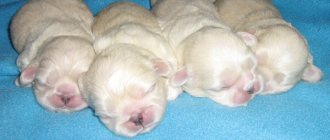If you like dogs of this breed and you decide to purchase such a wonderful pet, then please carefully study all the nuances of their maintenance and upbringing.
After reading this article, you will learn about the characteristics of Rottweiler puppies, the rules for caring for them and what you should pay attention to when choosing and purchasing. And also how to properly raise a puppy of this beautiful breed.
What it looks like: description and photo
Let's look at what a Rottweiler puppy looks like, and also give photos of puppies at 1, 2 or more months.
Newborn
From birth, Rottweiler puppies are black in color, with clear light tan markings, mainly located in the area of the almond-shaped eyes, as well as in the cheekbones, neck, chest and paws. Babies' skin is smooth. The ears are hanging, triangular in shape. The tail is elongated.
Babies are born blind and helpless, they move by crawling, so for the first month of life they are highly dependent on their mother and are not able to survive without her care.
By month
Let's describe Rottweiler puppies by month:
- At the initial stage, that is, in the first and second months of life, puppies only need to satisfy their physiological needs. This is warmth, sleep and mother's milk.
- Starting from the second month, puppies are actively growing and developing, adapting to the environment, becoming familiar with their habitat and smells.
- From approximately three months onwards, a particularly important period in a dog’s life begins; this is the process of socialization. The puppy gets used to the environment, begins to feel like a part of what is happening, actively engaging in games with its brothers. At this age, you can slowly begin to train your dog.
- The next stage is called dominance. Sometimes puppies during this period become disobedient and begin to show character. It is important not to miss the moment and show the pet where its place is and who is boss in the house.
- After a year, the dog begins a transition period, active maturation continues, manifested in increasing independence from its owner. Therefore, at this age, the puppy must be actively trained and accustomed to following the owner’s commands.
- By the age of two, Rottweilers reach full physical and mental maturity.
Temperament of a Rottweiler dog
This breed is distinguished by its innate belligerence, because the pet is ready to defend its owner at any second. The Rottweiler gets along well in a family with children, dutifully enduring their whims and tricks. In addition, the dog happily carries out orders for family members, but outside the walls of the apartment the animal’s good nature disappears. Any stranger - an adult or a child - is positioned by the Rottweiler as a possible threat, and the dog does not change this rule.
The Rottweiler is considered a one-owner dog. If the owner changes, the animal endures this moment very hard. The pet may become depressed, run away, or display uncontrolled aggression. And if you begin to pet or treat another four-legged animal in the presence of your dog, you will see discontent coupled with jealousy in all colors. The Rottweiler does not like sharing the owner's attention with other animals.
Oddly enough, representatives of the above breed are very sensitive to turmoil, hubbub, and everyday disagreements. When owners loudly sort things out, and this happens often, such unpleasant events can affect the mental side of the pet.
A Rottweiler that grew up in a nervous environment often has behavioral deviations and can show aggression towards its owner.
The pet attacks the offender quickly, without warning. A representative of this breed, overcome with anger, does not feel pain, and therefore it is almost impossible to drag away a dog that has attacked an animal or person. Meanwhile, Rottweilers are not characterized by particular imbalance: after the so-called fight, the dog cools down quickly enough and does not make repeated attempts to attack.
Table of height and weight by month
| Age | Height (male/female) height at withers (cm) | Weight (male/female) (kg) |
| 1 month | 22/20 | 3,5/4,5 |
| 2 months | 33/29 | 9/8 |
| 3 months | 48/47 | 17/14 |
| 4 months | 51/51 | 23/17 |
| 5 months | 56/56 | 31/24 |
| 6 months | 60/59 | 35/30 |
| 7 months | 64/61 | 40/34 |
| 8 months | 66/62 | 50/36 |
| 9 months | 66/62 | 50/36 |
| 10 months | 67/63 | 50/36 |
| 11 months | 67/63 | 50/38 |
| 12 months | 67/63 | 50/42 |
Basic norms
General appearance and main proportions
According to the standard, Rottweilers have a medium or slightly large build. But at the same time, they should not look too heavy or, on the contrary, light. The dog's limbs should not be long, otherwise it will move awkwardly. An impressive appearance indicates that the animal has qualities such as durability, natural strength, ingenuity and dexterity.
Ideally, the Rottweiler's height should be about fifteen percent of its body length (from the chest to the ischial tuberosities).
Characteristics
Rottweilers are quite peaceful animals with a balanced psyche. Dogs of this breed are good with children and form strong and long-lasting bonds with their owners. Protecting the family until the last breath is the main task of their life, which Rottweilers successfully cope with.
Accustomed to the basics of discipline and having a strong will, Rottweilers, with proper training, can become easily controlled animals. However, only an experienced dog breeder with leadership qualities can cope with a Rottweiler. After all, dogs of this breed are quite stubborn and independent.
Movements
Dogs of this breed prefer to trot. Moreover, while running, the line of the Rottweiler’s back remains flat and relatively calm. The animal moves confidently, pushing strongly off the ground with its paws. The harmonious movements of the dog should not be hampered by anything, especially with maximum swings of the limbs.
Head
The Rottweiler has a small oval-shaped head. Moreover, between the ears it noticeably expands, forming a small bulge. The bump on the back of the head is slightly pronounced, while the transition from the forehead to the muzzle (stop) is very noticeable. The muzzle is proportional to the skull - not too long or short.
The voluminous nose has large, clearly visible nostrils. The nose color is always black.
Black pigmented jowls that fit tightly together should have closed corners. According to the standard, it is better if the gum shade is as dark as possible.
The jaws are quite wide in shape, with noticeably developed muscles, with a full set of teeth (forty-two pieces) and a scissor bite.
The cheek area is clearly defined.
Medium-sized eyes with tight-fitting eyelids have an oval (almond-shaped) shape. Eye color is dark brown.
The triangular ears are set quite high and are relatively far apart. The edges of the drooping ears touch the cheekbones, making the part of the skull between them visually wider.
The slightly elongated neck is well developed physically. The nape line is slightly curved. There is no subcutaneous fat or skin folds.
Frame
The body of a Rottweiler consists of:
- straight line of a strong back;
- short lower back;
- voluminous croup, slightly rounded, barely noticeably sloping;
- a voluminous chest, approximately half the height of the dog;
- belly pulled closer to the groin;
- natural or docked (up to two vertebrae) tail.
Males must have two fully developed testes, located entirely in the scrotum.
Limbs
The dog's straight, relatively far apart forelimbs are well developed physically. The angle of the horizontal and the blade should be forty-five degrees. The shoulders fit very tightly to the dog's body. The rounded paws have tightly standing, bent toes with strong, always black claws.
The dog's straight, widely spaced hind legs have an obtuse angle at the hock joints and the same angle between:
- pelvic region and long, physically developed thighs;
- thighs and wide, muscular calves.
The legs of the hind legs should be slightly longer than the front legs.
Outer covers
The skin fits tightly around the dog's body without forming folds. However, when a Rottweiler is in a state of interest or alertness, the skin on its forehead may form a few slight wrinkles.
Shorthaired Rottweilers have a coat consisting of:
- thick guard hairs, tightly adjacent to each other, hard to the touch;
- undercoat, the length of which should not exceed the length of the guard hair.
In the area of the Rottweiler's hind legs, the hairs are slightly longer than on the body.
Color
The base coat color of this dog breed is black. However, on the body of the Rottweiler there are tan spots of a rich brown hue: in the muzzle area, mainly under the eyes and on the cheekbones, in the lower part of the neck, on the chest, in the lower part of the limbs, near the tail.
Dimensions
The height of male Rottweilers varies from 61 centimeters to 68 centimeters. The height of Rottweiler females varies from 56 centimeters to 63 centimeters.
Male Rottweilers should weigh approximately 50 kilograms. Rottweiler females should weigh approximately 42 kilograms.
Now let's move away from the main norms of the standard and talk about what interests many potential owners - what the weight of a Rottweiler should be at different stages of its life: 1, 2, 3, 4, 5, 6, 7, 8, 9, 10, 11 months.
The puppy's weight must be constantly monitored. This information will help the owner understand whether his pet is developing normally and correct the situation in a timely manner if something goes wrong.
For example, if a baby at 5 months weighs much less than the minimum twenty-two kilograms, it means that he is either incorrectly or poorly fed, or he is unhealthy. And if the puppy is only 5 months old, and its weight already exceeds the maximum mark for this age, the dog is most likely developing obesity.
When you weigh a puppy of this breed for the first time, you may be surprised at how small it is. The weight of a newly born baby is about 350-500 grams.
Rottweiler puppies at 1 month are noticeably different from newborns, since in four weeks they should gain about two to three kilograms. Sometimes a month-old baby gains about four kilograms. Naturally, if he was fed correctly and has no health problems. By three to four months, the weight of a Rottweiler puppy should increase by about 5 times.
You can compare your puppy's weight to standard measurements using the following list:
- newborn puppy: female – 350-450 g, male – 400-500 g;
- 1 month: female – 2-3 kg, male – 3-4 kg;
- 2 months: female – 5-7 kg, male – 8-10 kg;
- 3 months: female – 12-14 kg, male – 15-17 kg;
- 4 months: female – 15-17 kg, male – 21-23 kg;
- 5 months: female – 22-24 kg, male – 29-31 kg;
- 6 months: female – 28-30 kg, male – 33-35 kg;
- 7 months: female – 32-34 kg, male – 38-40 kg;
- 8 months: female – 44-46 kg, male – 34-36 kg;
- 9 months: female – 34-36 kg, male – 48-50 kg;
- 10 months: female – 36-38 kg, male – 48-50 kg;
- 11 months: female – 42 kg, male – 50 kg.
Don't worry if your baby's weight does not match the standard norms, because these are approximate data. The main thing is that the puppy is healthy and active.
Vaccinations
The lifespan of a large breed dog is about 8-10 years. Sometimes this figure can increase for another 3-4 years. Due to their brutal appearance and fairly large build, Rottweilers give the impression of being strong and hardy. However, this breed of dog has plenty of its own diseases.
Innate immunity acquired through mother's milk protects the puppy for up to two months after birth. Further, starting from the age of two months, it is necessary to develop the acquired immunity of the dog through timely vaccination.
This measure will further help protect not only the dog’s body from various types of diseases, but will also protect the household members themselves from possible health problems. Agree, an unvaccinated dog infected, for example, with rabies, will pose a threat to others .
The vaccine is usually placed either in the scruff of the neck or in the hip of the puppy. For each dog, the veterinarian creates a special medical passport, which records all the procedures performed. According to the vaccination rules, Rottweiler puppies must be vaccinated against:
- rabies;
- adenovirus;
- leptospirosis;
- parainfluenza virus;
- parvovirus enteritis.
The first vaccination for a puppy is carried out at the age of 6-8 weeks. This is usually done by breeders, so most likely your puppy will already have his first vaccination. Booster vaccinations will be needed every three weeks until the puppy is 20 weeks old. Further, up to two years, revaccination is done against plague, parvovirus and parainfluenza virus.
Where to buy a puppy
Based on the purpose of the purchase and the financial side, you can purchase a puppy in a nursery or secondhand, for example, on the market or through an advertisement in a newspaper, magazine, or the Internet. If you decide to get a pet for your soul, then the origin of the animal is not so important, and it is possible to buy a baby at a low cost from a private owner. Meanwhile, we are not talking about the quality of the breed, and you are not immune from the fact that the pet does not have any hereditary diseases or other unpleasant nuances.
Rottweiler puppies with excellent pedigree, vaccinated according to age and tested for genetic diseases, with full documentation, are sold in the nursery. By the way, in Russia there are enough specialized nurseries that professionally breed animals. This provides a wide choice and cost diversity.
Care
Before buying a Rottweiler puppy, you need to learn about the rules of its maintenance and care . The breeders themselves can give you the necessary initial information when selling a puppy. To quickly adapt, it is necessary to create favorable conditions for the pet to stay in its new home. Prepare a personal place for the dog, a muzzle, a collar for walking, a place for feeding, hygiene, various toys for animals, etc.
It is necessary to walk the dog daily, for at least an hour, preferably at the same time, which contributes to its proper physical development and activity. Dogs that live in an apartment or house are subject to year-round shedding, therefore, special care is required for the animal’s fur.
Since Rottweilers have a relatively short coat, the animal must be bathed regularly, approximately once every three or four months. And also comb with a special brush at least once a week. During the seasonal molting period every day.
Otherwise, caring for a Rottweiler is no different from caring for other dogs :
- after a walk, wash your paws and face;
- periodically take care of your eyes and ears;
- and be sure to brush your teeth.
Deviations from the standard
Defects
Any, even small, deviations from the standard can be counted as flaws. Each deviation is considered by the judges individually.
The following parameters are considered defects:
- poorly developed muscles of the dog’s trunk;
- non-standard physique: light or vice versa - too heavy;
- elongated or shortened muzzle;
- narrow or lightweight skull;
- poorly defined stop;
- saggy jowls;
- shaved without black pigmentation;
- narrow jaws;
- low set ears;
- erect position of the ears;
- eyes are not almond shaped;
- elongated or shortened neck;
- folds on the neck;
- narrow, long or vice versa – short body;
- uneven back line;
- strongly sloping croup;
- barrel-shaped chest;
- tail set low or too high;
- undeveloped muscles of the limbs;
- soft wool;
- too big sun spots.
Disqualifying faults
The defects that can permanently end a Rottweiler's exhibition career include the following deviations from standard parameters:
- a male behaves like a female and vice versa;
- cowardice;
- uncontrolled aggressiveness;
- shyness;
- unbalanced psyche;
- not brown eye color;
- eye diseases, such as cataracts or strabismus;
- not a scissor bite;
- incomplete set of teeth;
- coat is too long;
- curly hair or with a slight wave;
- non-standard color;
- white tan spots.
Share with us in the comments how old your dog is and how much it weighs. Does your pet meet the standard?
If you liked the article, please like it.
Upbringing
The Rottweiler is a service dog and belongs to the Molosser group. This breed got its name from the city of Rottweil in southwestern Germany. There are four main types of dogs of this breed :
- German (the German type is considered the most ancient);
- American;
- English;
- FCI (Federation Cynologique Internationale).
They are all quite similar to each other, the difference is mainly in character and physical parameters. Rottweilers are excellent protectors of their owner, with a strong character. They are quite smart, serious and very loyal animals.
The most important thing to consider is that Rottweilers require fairly strict and consistent upbringing and training . Early socialization is required so that later it will not be stressful for him.
In addition, Rottweilers grow quickly during puppyhood, and this must be taken into account in nutrition and amount of training. They are generally patient with children, but parents should make sure that children know how to communicate properly with a dog and not leave them unattended when interacting with a dog.
It will be great if children are involved in the process of raising a dog, as this will bring the family closer together.
Why do you dock your tail: is it worth it?
Over the course of their long history, Rottweilers have performed a variety of functions. These pets served man in all sorts of ways, that is, they were fighting dogs, baiting dogs, and cattle drives. In ancient times, a docked tail was a necessity. This procedure was carried out so that the pet would receive fewer injuries from other animals in the course of performing its duties.
Cupping subsequently began to be done for decorative purposes. Today, by and large, there is no particular need for this, since the majority of Rottweiler dogs lead a peaceful existence. This breed is easy to recognize with the true size of the tail. At the same time, it has been proven that a dog whose tail is docked is developmentally delayed.
In any case, only the breeder decides whether it is worth docking a Rottweiler’s tail. The buyer either looks for a seller with certain humanistic views, or reserves a puppy and agrees on the integrity of the tail in advance. Although the latter is somewhat difficult, because the tail of Rottweilers is docked within the first 3 days of life, and at this age it is problematic to choose a pet.
Prices
Prices for puppies of dogs of this breed depend on the class into which they are divided. Today there are three types :
- pet class (from 12 to 18 thousand rubles);
- breed class (from 18 to 50 thousand rubles);
- show class (from 50 thousand to 100 thousand).
The first option is the cheapest. Dogs of this class are bought for themselves, as a pet, and also for home protection. The price of puppies of the second class is higher than the first. However, they have minor deviations from the standard and are therefore not suitable for participation in specialized exhibitions.
For breeding the breed, puppies of the third, show class are suitable . Their price is an order of magnitude higher than the first two, however, they are worth it. This includes only elite dogs, with good pedigree and the best performance. Perfect for exhibition.
How to choose a kitten?
Buying a puppy of this breed is not an easy task, although their popularity is quite high. You should not buy the first puppy you come across, even if you do not intend to breed them, but simply dream of such a dog as a family pet.
Due to its rather impressive size, if improperly raised and handled, such a dog can pose a threat to people. It is better to spend time and buy a smart, healthy and purebred dog .
Representatives of this female dog breed are more obedient and are considered less aggressive. However, with them you should be prepared for such troubles as estrus and childbirth. A male dog should be chosen by those who are confident enough that they can cope with their not always submissive nature.
When choosing a puppy, be sure to evaluate its appearance . A healthy dog has a smooth and shiny coat with even, symmetrical markings. Straight tail. Wet and cold nose, clean eyes and ears. A scissor bite is a sign of a good quality puppy. Take a closer look at how the puppy behaves in communication, whether he is calm and balanced enough. If there are signs of fearfulness or aggression, it would be better to abandon such a specimen.
How much does it cost in Russia?
In our country, the average price of such a purchase varies from three to one hundred thousand rubles, depending on the class. Puppies of different classes can be born in one litter, according to generally accepted standards. When buying a purebred show-class puppy, you need to make sure that the seller is honest and experienced. Check the availability of the necessary documents.
Excursion into history
According to some sources, modern Rottweilers are descendants of legionnaire dogs from Ancient Rome. They guarded the warriors' cattle, which they drove with them when they went on campaign. In appearance, the dogs resembled not only Rottweilers, but also Neapolitan mastiffs.
The Rottweiler dog breed received its name from the city of Rottweil, which is located in Germany. In it, farmers held fairs, and dogs helped them manage their livestock.
Pets had many important tasks. They herded the cows into a herd and made sure no one was left behind. Sometimes the dogs had to subdue aggressive bulls.
When trains began to operate, cattle began to be transported by rail, and the profession of a driver ceased to be relevant. The police paid attention to Rottweilers, and the popularity of the breed increased.
Nutrition
Dog handlers advise alternating dry food mixtures and natural products when feeding an animal.
The following ingredients should be included in the dog's menu:
- Boiled meat (turkey, chicken, veal).
- Porridge (rice, buckwheat, millet).
- Low-fat cottage cheese, kefir or fermented baked milk.
- Stewed vegetables (carrots, zucchini, eggplant).
Give your dog pieces of fruit and cheese (in small quantities) as treats. Water for the animal must be boiled and cooled to room temperature before serving. Dry food should be given to the dog after preliminary soaking.
The food mixture must contain sufficient quantities of the following components:
- Vitamin D
- Calcium.
- Phosphorus.
- Omega-3 fatty acids and microelements.
- Prebiotic fibers that normalize the functioning of the digestive system.
Rottweilers have a tendency to overeat, so the owner must feed the animal strictly on a schedule. Puppies should be given food 4-5 times a day. An adult dog needs two meals a day.
Interesting Facts
- The pressure of the Rottweiler's jaws reaches 22 atmospheres (the pit bull and the German shepherd have a less powerful grip).
- Rottweiler attacks on people accounted for 16% of all deaths from dog bites in America (statistical studies have been conducted over the past 20 years).
- A Rottweiler named Buster saved the life of an 8-year-old American girl from Idaho. She fell from her horse, injured her head and lost consciousness. There was only a faithful dog nearby. He ran to the owners of the nearest farm and led them to the girl. Doctors operated on the little rider in time, and she remained alive.
- Rottweilers are officially banned in Israel, Portugal, Spain, the USA and France.
- In the German town of Rottweil there is a bronze statue of a Rottweiler that is considered a local landmark.
- Rottweilers serve in the Russian police (standard service life is 8 years). Rottweilers are also used to guard camps and escort prisoners.
